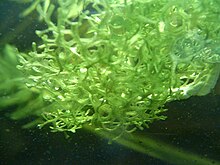
Salvinia molesta, commonly known as giant salvinia, or as kariba weed after it infested a large portion of Lake Kariba between Zimbabwe and Zambia, is an aquatic fern, native to south-eastern Brazil. It is a free floating plant that does not attach to the soil, but instead remains buoyant on the surface of a body of water. The fronds are 0.5–4 cm long and broad, with a bristly surface caused by the hair-like strands that join at the end to form eggbeater shapes. They are used to provide a waterproof covering. These fronds are produced in pairs also with a third modified root-like frond that hangs in the water.

Water gardens, also known as aquatic gardens, are a type of water feature. They can be defined as any interior or exterior landscape or architectural element whose primary purpose is to house, display, or propagate a particular species or variety of aquatic plant. The primary focus is on plants, but they will sometimes also house ornamental fish, in which case the feature will be a fish pond.

Hottonia palustris, also water violet or featherfoil, is an aquatic plant in the family Primulaceae.

Riccia is a genus of liverworts in the order Marchantiales.

A hydrosere is a plant succession which occurs in an area of fresh water such as in oxbow lakes and kettle lakes. In time, an area of open freshwater will naturally dry out, ultimately becoming woodland. During this change, a range of different landtypes such as swamp and marsh will succeed each other.

Amblystegium serpens, the creeping feathermoss or nano moss, is a species of moss. Its range includes Britain, where it is a common species.
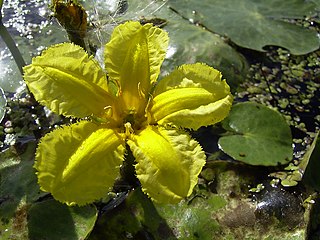
Nymphoides peltata is perennial, rooted aquatic plant with floating leaves of the family Menyanthaceae.

Marsilea quadrifolia is a herbaceous plant found naturally in central and southern Europe, Caucasia, western Siberia, Afghanistan, south-west India, China, Japan, and Vietnam, though it is considered a weed in some parts of the United States, where it has been well established in the northeast for over 100 years. Its common names include four leaf clover; European waterclover (USA); sushni (India); aalaik keerai (Tamil).
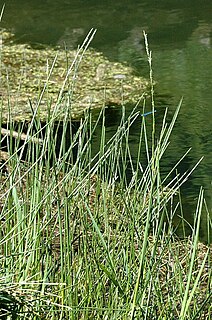
Glyceria fluitans, known as floating sweet-grass and water mannagrass, is a species of perennial grass in the genus Glyceria native to Europe, the Mediterranean region and Western Asia and occurring in wet areas such as ditches, riverbanks and ponds.

Ranunculus fluitans is a species of buttercup. It is a perennial water plant, that when in favourable conditions it can grow up to 6 m (20 ft) height.

The yellow-bellied slider is a land and water turtle belonging to the family Emydidae. This subspecies of pond slider is native to the southeastern United States, specifically from Florida to southeastern Virginia, and is the most common turtle species in its range. It is found in a wide variety of habitats, including slow-moving rivers, floodplain swamps, marshes, seasonal wetlands, and permanent ponds. Yellow-Bellied Sliders are popular as pets.

Platyhypnidium riparioides, the long-beaked water feathermoss, is a species of aquatic moss commonly found in many regions. This species is among the largest aquatic mosses growing up to 15 cm long. P. riparioides grows in a procumbent or pendulous fashion along rocks and tree roots and may form extensive lax mats of many intermingled plants. It is widely distributed South of the Arctic and can grow abundantly in suitable areas.
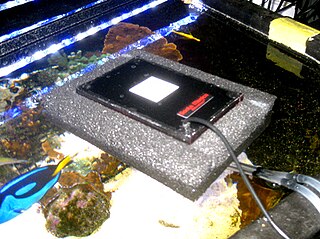
An algae scrubber is a water filtering device which uses light to grow algae; in this process, undesirable chemicals are removed from the water. Algae scrubbers allow saltwater, freshwater and pond hobbyists to operate their tanks using natural filtration in the form of primary production, much like oceans and lakes.

Polytrichum juniperinum, commonly known as juniper haircap or juniper polytrichum moss, is an evergreen and perennial species of moss that is widely distributed, growing on every continent including Antarctica.
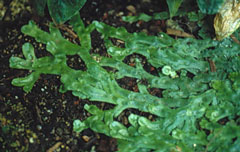
Conocephalum conicum, the great scented liverwort, common mushroom-headed liverwort or snakeskin liverwort, is a liverwort species in the genus Conocephalum .

Fontinalis antipyretica, greater water-moss, or common water moss, is a species of submerged aquatic moss belonging to the subclass Bryidae. It is found in both still and flowing freshwater in Europe, Asia, Greenland and Africa. In North America it is found in most Canadian provinces with a seaboard and most US states except the most southern.

In biology, semiaquatic can refer to various types of animals that spend part of their time in water, or plants that naturally grow partially submerged in water. Examples are given below.
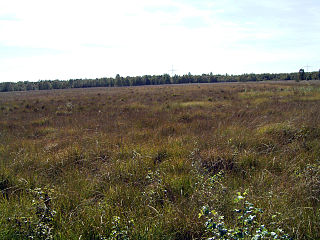
A floating mat is a layer of mosses and other, especially stoloniferous, plants that grows out from the shore across the surface of a lake or pond. This type of habitat is protected and is designated in the European Habitats Directive as "LRT No. 7140 Transition and Floating Mat Bogs".
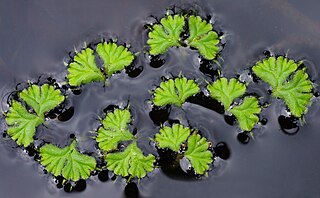
Ricciocarpos natans is the only species in the genus Ricciocarpos, a genus of liverworts in the family Ricciaceae. It was formerly listed in 1759 as a species of Riccia by Linnaeus, but then assigned to a new genus of its own in 1829 by August Carl Joseph Corda.

Phyllanthus fluitans, also known as the red root floater, floating spurge, or apple duckweed is a species of free floating aquatic plant and herb in the family Phyllanthaceae. This species is one of the only three non-terrestrial species in the genus Phyllanthus, with the other species being P. leonardianus and P. felicis. The generic name comes from Ancient Greek meaning leaf flower, and the specific name comes from Latin meaning floating or float. It was described in 1863 by George Bentham and Johannes Müller Argoviensis.
